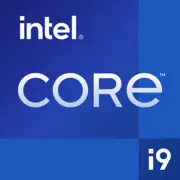Intel Core i9-12900KS

Intel Core i9-12900KS: A Comprehensive Review of the Hybrid Flagship of 2025
Relevant as of March 2025
1. Key Specifications: Architecture, Process Technology, and Key Features
Alder Lake Hybrid Architecture
The Intel Core i9-12900KS, released in 2022, remains relevant in 2025 due to its unique hybrid architecture. The processor combines 8 Performance-cores (P-cores) with Hyper-Threading support (16 threads) and 8 Efficient-cores (E-cores, 8 threads). This allows for effective task allocation: P-cores handle high-performance applications, while E-cores manage background processes.
Intel 7 Process Technology and Frequencies Up to 5.2 GHz
Manufactured using a 10nm process (marketed as Intel 7), this chip demonstrates record frequencies. The base frequency for P-cores is 3.4 GHz, but in Turbo Boost Max 3.0 mode, they can boost up to 5.2 GHz. The E-cores have a stated Turbo boost of up to 4.0 GHz. This makes the i9-12900KS one of the fastest processors for single-threaded tasks even three years after its release.
Performance and Cache
With scores of 2697 points in Geekbench 6 (Single-Core) and 16271 (Multi-Core), the processor outperforms many current mid-range models. The L3 cache size is 30 MB, which accelerates data processing in games and professional applications.
Key Features
- Support for PCIe 5.0 (up to 16 lanes) and DDR5.
- Integrated graphics Intel UHD Graphics 770 — suitable for office tasks or emergencies without a discrete graphics card.
- Thread Director technology for optimizing core workload distribution.
2. Compatible Motherboards: Sockets and Chipsets
LGA 1700 Socket
The processor uses the LGA 1700 socket, which is supported by the Z690, H670, B660, H610 chipsets. By 2025, the prices for compatible motherboards have decreased:
- Z690 (from $180): Best choice for overclocking (ASUS ROG Maximus Z690 Hero — $250).
- B660 (from $120): Optimal for builds without overclocking (MSI MAG B660 Tomahawk — $140).
Selection Features
- DDR4/DDR5 Support: Some motherboards work only with DDR4 (e.g., Gigabyte B660M DS3H DDR4), while others support DDR5. Check specifications!
- PCIe 5.0: Available only on Z690/H670 motherboards.
3. Supported Memory: DDR4 vs DDR5
The processor is compatible with both standards, but not simultaneously. By 2025, DDR5 has become more accessible; however, DDR4 is still relevant for budget builds:
- DDR5-4800 (from $80 for 16 GB): Suitable for rendering and 4K gaming (example: Kingston Fury Beast DDR5-5200).
- DDR4-3200 (from $50 for 16 GB): Savings of up to 30% without significant performance loss in most scenarios.
Tip: For gaming, the difference between DDR4 and DDR5 is minimal (1-5% fps), but in tasks like video compression, DDR5 can speed up processes by 15-20%.
4. Power Supply Recommendations
With a TDP of 150 W and peak consumption of up to 240 W (in stress tests), a quality power supply is required:
- Minimum 750 W: For example, Corsair RM750x (80 Plus Gold, $120).
- For systems with RTX 4080/4090: Better to use 850-1000 W (Seasonic PRIME GX-850, $150).
Important: Cheap PSUs may not handle peak loads, leading to system reboots.
5. Pros and Cons of the Processor
Advantages
- Best-in-class single-threaded performance.
- Support for DDR5 and PCIe 5.0 (relevant for next-generation NVMe SSDs).
- Hybrid architecture increases energy efficiency under mixed workloads.
Disadvantages
- High heat output: Without liquid cooling (e.g., NZXT Kraken X63), temperatures can reach 100°C.
- Price: In 2025, the new i9-12900KS costs about $500, which is more expensive than the Ryzen 9 7900X ($450).
- Limited support lifespan: No updates for new standards like PCIe 6.0.
6. Use Case Scenarios
Gaming
In games like Cyberpunk 2077 or Starfield, the processor ensures stable 120+ fps at 1440p when paired with an RTX 4070 Ti. However, for 4K, the emphasis shifts to the graphics card.
Work Tasks
- Rendering: In Blender, the BMW scene renders in 4.2 minutes (compared to 5.1 with the Ryzen 9 5900X).
- Video Editing: In Adobe Premiere Pro, an 8K video processes 15% faster than on the i9-11900K.
Multimedia
Streaming on OBS with encoding through Quick Sync (integrated graphics) reduces CPU load, maintaining fps in games.
7. Comparison with Competitors
AMD Ryzen 9 7950X
- AMD Advantages: 16 cores, PCIe 5.0 support across all lanes, lower power consumption (170 W).
- Disadvantages: In gaming, it lags by 5-8% due to lower frequencies. Price — $550.
Apple M3 Max
For macOS users, the M3 Max is more energy-efficient, but in Windows applications and games, the i9-12900KS retains its advantage.
8. Practical Assembly Tips
- Cooling: A 240mm liquid cooling system or top-tier air cooler (Noctua NH-D15) is mandatory.
- Case: At least 3 intake fans (Lian Li Lancool III).
- Motherboard: Don’t skimp on VRM — boards like the ASUS TUF Gaming Z690 can handle prolonged loads.
9. Conclusion: Who Should Choose the i9-12900KS?
This processor is worth choosing for:
- Gamers looking for maximum fps at 1440p.
- Professionals working with rendering and editing.
- Enthusiasts who value compatibility with DDR5 and PCIe 5.0.
Alternative: If the budget is limited, consider the Ryzen 9 7900X or Intel Core i7-13700K. However, for a top-notch system in 2025, the i9-12900KS remains a worthy choice.
Prices are current as of March 2025. Mentioned brands and models are used as examples.
Basic
CPU Specifications
Memory Specifications
GPU Specifications
Miscellaneous
Benchmarks
Compared to Other CPU
Share in social media
Or Link To Us
<a href="https://cputronic.com/en/cpu/intel-core-i9-12900ks" target="_blank">Intel Core i9-12900KS</a>